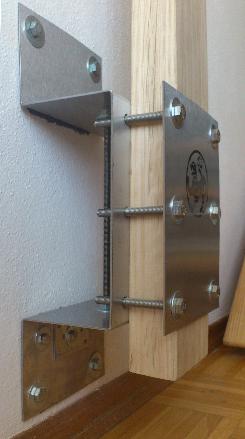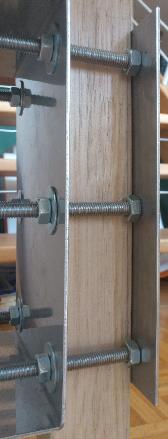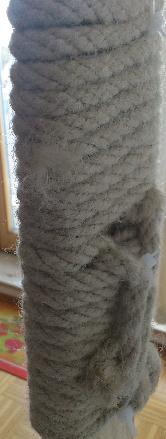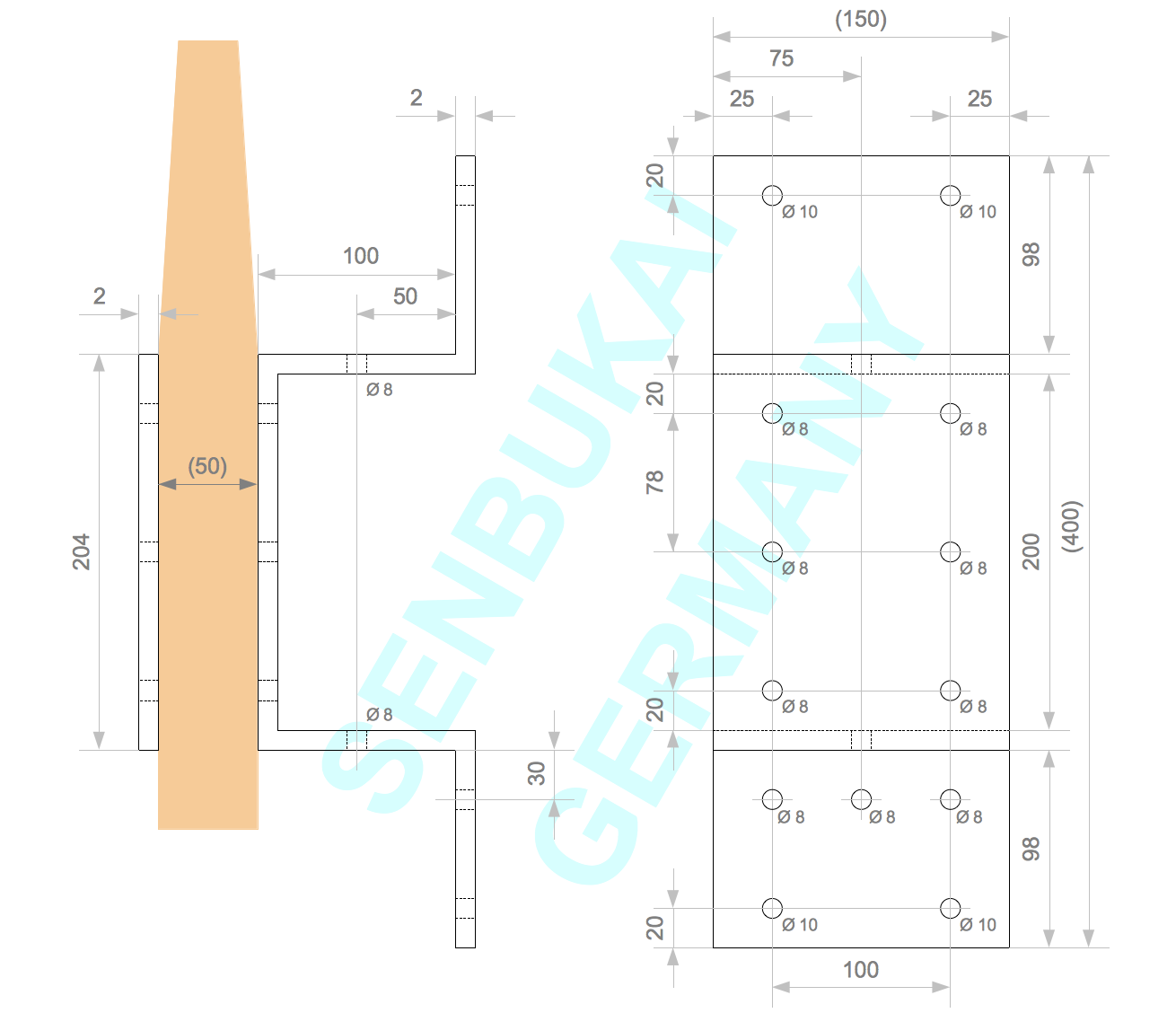

|
|
||
Building a makiwara |
||

The world of martial arts offers many possibilities of using training tools with and without a partner. In the traditional Okinawan martial arts, one of which is now called karatedo, there were many training devices made for the purpose of developing body and techniques. Even in the homes of people who did not participate in martial arts, you could find one device: the makiwara (jap. "bundle of straw"). Punching or kicking the makiwara has a healthy effect on the body, but therefore one should not apply maximum force, and the construction of the makiwara should provide elasticity. The harder you hit, the harder the restoring force pushes you back. This is the principle of the makiwara, and it is completely different to hitting just a solid wall or a punching bag. Keep in mind that hitting too hard makes insensitive to fine movements and it can cause damage to your whole body, especially to the joints. In Karate-Do the makiwara is used to improve body control while providing a technique for the activation of the chain of body joints. In other words, the technique should be applied with the use of one's whole body. By utilizing the entire chain of joints, you can obtain the maximum achievable impact with the economic use of energy. Even weak persons can train with this tool and learn how to execute a very effective fist thrust or open hand strike. While training with the makiwara, you can learn coordinated movement of your body. Every joint should be involved in the technique - for example a hip rotation or the shoulder including a small movement of the shoulder blade. Also correct distance, breathing and the use of the gravity - by lowering your cetre of gravity slightly - should be considered in order to optimize your technique. Referring to the Okinawan term muchimi ("elastical") - your tehnique should snap like a whip. In Budo you can only go further in your developent through practice. This is what we call training. But there is a difference between training one or two hours twice a week or feeling the need for training every day and just doing so for about 15 minutes each day. Your progress will be much faster when training regularly. This training tool is not recommended for beginners, who are new to the world of martial arts. The makiwara training is an intergrated part of traditional karate training and not simply training for toughening your extremities. In general you should start with softer hits and then, after some months you can try hitting more vigorously. A short warm-up ensures that your body is prepared for training. Take good care of your joints. About the mechanical principles and dimensions 
The following is a detailed introduction about the makiwara clamp and its dimensions. There are some points to be considered before setting up a makiwara: A standing makiwara fixed to the ground is doubtlessly the most robust type of makiwara. However, sometimes it is more practical to mount the makiwara on the wall, in order not to damage the wooden floor in your apartment. Then there are two types - the wall mounted standing makiwara and the hanging makiwara. How to build a hanging makiwara is explained in the well known karate litarature of sensei Gichin Funakoshi ("Karate-Do Kyohan"). - the makiwara should be placed in an upright position; a makiwara with its top leaning too far forward must be hit with an upward movement, which will result in a counterforce going down through your body and may damage your lower back. In general try to hold your lower back in a straight position, with the pelvis at the correct angel; relax your shoulders and try to hold your trunk upright leaning slightly forward to get more stability. To see how to stand or sit correctly, take a look at the book written by Aikido's great Sensei Morihei Ueshiba ("Budo - Teachings of the Founder of Aikido"). 
- The wood used for the makiwara is Japanese beech; it is about 140 cm high, 9 cm wide, and its thickness increases from head to base. At the base it is 5 cm whereas at the top it is only 1 cm thick - this ensures that it acts like a spring .You can buy this part form a distributor, such as Kamikaze Sportaktikel Vertriebs GmbH; you may have to shorten the wood, depending on your height. - The mounting plate has a u-type profile, in order to increase the distance between the wall and the top of the makiwara. The u-base is 20 cm long, the sides are 10 cm long; the whole profile is 40 cm high, 15 cm wide, and 2 mm thick, so the clamp is somewhat flexible. You can have a stainless steel profile made by your local locksmith - A shock-absorbing material about 1 mm thick is inserted between the wall and the u-type profile. Without this, the clamp would swing - which would be very irritating. 
- The wood itself is not drilled, and therefore not damaged - it is clamped beween a steel plate and the front of the u-type profile. Sideward movement of the wood is prevented by exact inward fitting of the screw nuts. The base is supported by a heavy duty angle plate. To give the u-type profile more stability against collapse when hit, a thread rod with 8 mm in diameter is vertically fixed beween both sides. 
- The six front screws and the four wall screws have 8 mm threads;the three screws at the bottom have 6 mm threads in order to align all of them without damaging the brick wall too much. Washer blades are normally used in combination with a special type of dowel for brick walls. - The top of the makiwara consists of two ropes, fixed to each other by means of three cable retainers; each rope has one cable loop clamped with a metal collar. The length of the top is about 20 cm; each rope is 1 cm thick and 2 m long. Alternatively one longer rope could also be used. I recommend using a soft type of rope, or rice straw from Okinawa - this ensures an additional damping effect to save your knuckles. - The diagram below shows the u-type profile, which is made of stainless steel. This drawing is not to scale, all dimensions are in mm. 
About the author: Christian John was born on 26 December, 1984 in Halle a.d.Saale, Germany. He began practising Japanese shotokan karate, in Munich, at the age of eleven. After a break of 6 years he returned to the karate world in 2006. His first contact with Asai Karate was in 2007 through his sensei Gerhard Schoenfelder. The author has also visited the annual I.J.K.A. Master Asai Memorial Camp in Switzerland, where, in 2010, he met Sensei Hsin-Koei Chen in 2010, who had studied Karate for over 40 years, under his uncle Sensei Tetsuhiko Asai. The author has practised the Okinawan art of Jinbukan Kobudo since 2008 and, in 2011 he decided to start with training in Shudokan Aikido. He studied photonics, and mechatronics major in medical engineering. In 2011, he also started to learn Japanese. Since he was a three years old, he has always said "ueben ueben ueben" which simply means "practise, practise, practise". Until the end of 2013 he was president of SENBUKAI GERMANY, which is the German branch of the I.J.K.A. This organization was founded to preserve traditional karate and its special Japanese spirit. |